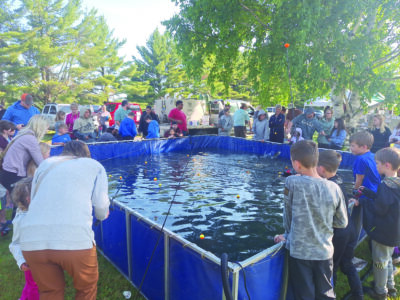Repurposing old mines for hydro pumping electrical storage
HOUGHTON–Adapting old, abandoned mines to provide hydro pumping storage has become a focus of several people at Michigan Technological University. It has included a thorough study involving an abandoned iron mine in Michigan’s Negaunee Township that began more than four years ago.
Timothy Scarlett, a professor of anthropology and archaeology at Michigan Tech, says the idea for the study, and its potential for drastically reducing critical-stage electrical storage issues all over the world, began in his office with a simple question.
One day, Scarlett’s colleague, Roman Sidortsov, walked into his office and asked why there were no water power systems in the abandoned mines in the Upper Peninsula.
“That started a conversation about the fact that water power has been very important and water is very important in mining for many reasons,” said Scarlett, “but, as we were talking through that, he meant why don’t we have hydro power stations up here.”
Scarlett said that Sidortsov, an associate professor of Energy Policy in Michigan Tech’s Social Science Department, had recently returned from a meeting in England, where the topic of electrical grids and electrical systems were the highlighted topics. Among the discussions was the increasingly pressing issue of energy storage globally and creating hydro pumping storage in abandoned mines as a potential means of addressing the storage issue. A conversation that began in Scarlett’s office rapidly evolved into a two-year study, beginning in January 2019, that focused on hydro pumping storage, using the abandoned Mather B Mine in Negaunee as its model.
The team of scientists conducting the study, all from Michigan Tech, consisted of:
•Roman Sidortsov, MTU, Associate Professor of Professor of Energy Policy; University of Sussex, Senior Fellow for Energy Justice and Transitions;
• Shardul Tiwari, MTU, Doctoral student, Social Sciences;
•Timothy Scarlett, MTU, Associate Professor of Anthropology and Archaeology;
•Ana Dyreson, MTU, Assistant Professor, Mechanical Engineering-Engineering Mechanics;
• David Watkins, MTU, Distinguished Professor of Civil and Environmental Engineering.
The study looked at the potential use of Negaunee’s abandoned iron mine for underground pump-hydroelectric energy storage, using a system much like the pump-hydro storage plant at Ludington, but with a major environmental advantage. Such a system, constructed in an abandoned mine would use water already in the mine, both lifting it and allowing it to cascade onto turbines. The mine water used would be discharged directly back into the mine and the entire system would be underground. It would not require an external water source, as does the Ludington hydro storage plant.
A self-contained facility would not have the same adverse impacts on surface water and landscape that could concern people about a similarly-scaled facility built aboveground.
Scarlett said the Mather Mine was selected because it possesses traits that the research team has determined a mine must have:
• Both flooded and unflooded levels;
• Enough volume for utility-scale hydro storage;
• Enough capacity for the hardware, such as turbines and pumps and “robust underground structure.”
The study was funded by the Alfred P. Sloan Foundation “Enhancing electrical grid and community resilience through repurposing decommissioned mines into underground pumped storage facilities,” and ran from Jan. 2019 to Sept. 2021. The report was published in Oct. 2021.
The report states that between January 2019 and October 2021, the research team completed a landscaping study that examined the technical, economic, legal, regulatory, water quality, social, and community engagement opportunities and barriers for repurposing decommissioned mines into pumped underground storage hydro (PUSH) facilities.
The report explains that PUSH is a type of closed-loop, pumped storage hydro (PSH) technology whereby the upper reservoir is located either at or below the ground’s surface, while the lower reservoir and turbo-machinery are built entirely underground.
“This closed-loop PSH application is capable of providing essential grid services while also mitigating and remediating environmental damage caused by past mining activities and offering sustainable economic development opportunities for post-mining communities,” the report states. These attributes of PUSH can mitigate the complexities of the licensing and permitting process and improve the economic feasibility of PUSH facilities. As noted in the literature, a PUSH facility can be developed using mature technological systems–materials and machinery–used by conventional PSH.
The case study found that that the Mather Mine could harness ultra-long duration storage, providing continuous power to 30,000 people for 3.5 months — at a profit — once it is built. The study also found that, based upon how it was designed, if the Mather B was a hydropower station, it would be among the largest such facilities in the world. It is a battery, however, not a generator.
The principle behind PSH is simple, the report states: When there is a plentiful or even excessive supply of electric energy on the grid, water is pumped from the lower reservoir to an upper reservoir. When there is an elevated demand, water cascades down to the lower reservoir through a penstock and hydroelectric turbine generating electricity in the process. In a sense, a PSH facility serves as a battery providing grid services ranging from backup electricity storage to voltage control.
The report states that the largest PSH facility, the Bath County Storage Station in Pennsylvania, often referred to as the “largest battery in the world,” has a maximum power capacity of 3 gigawatts and a maximum storage capacity of 24 gigawatt hours. This battery, when fully “charged,” can power 2.5 million U.S. homes for eight hours.
Author’s Note: This is Part 2 of an ongoing series that examines the potential use of abandoned mines in the Upper Peninsula for hydro pumping electrical storage.





